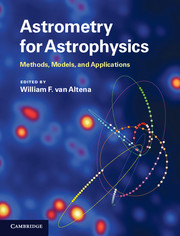Book contents
- Frontmatter
- Contents
- List of contributors
- List of acronyms
- Preface
- Part I Astrometry in the twenty-first century
- Part II Foundations of astrometry and celestial mechanics
- 4 Vectors in astrometry: an introduction
- 5 Relativistic foundations of astrometry and celestial mechanics
- 6 Celestial mechanics of the N-body problem
- 7 Celestial coordinate systems and positions
- 8 Fundamental algorithms for celestial coordinate systems and positions
- Part III Observing through the atmosphere
- Part IV From detected photons to the celestial sphere
- Part V Applications of astrometry to topics in astrophysics
- Index
- References
6 - Celestial mechanics of the N-body problem
from Part II - Foundations of astrometry and celestial mechanics
Published online by Cambridge University Press: 05 December 2012
- Frontmatter
- Contents
- List of contributors
- List of acronyms
- Preface
- Part I Astrometry in the twenty-first century
- Part II Foundations of astrometry and celestial mechanics
- 4 Vectors in astrometry: an introduction
- 5 Relativistic foundations of astrometry and celestial mechanics
- 6 Celestial mechanics of the N-body problem
- 7 Celestial coordinate systems and positions
- 8 Fundamental algorithms for celestial coordinate systems and positions
- Part III Observing through the atmosphere
- Part IV From detected photons to the celestial sphere
- Part V Applications of astrometry to topics in astrophysics
- Index
- References
Summary
Introduction
The dynamics of celestial bodies is an important topic for astrometry. First, as we have seen in the previous chapter, the position and velocity of the observer with respect to the BCRS as well as the positions and velocities of Solar System objects are necessary to reduce observations for aberration, parallax, and gravitational light deflection. Second, astrometric observations represent an important source of information allowing us to model the dynamical behavior of various celestial systems: Earth satellites, interplanetary stations, major and minor planets of the Solar System, binary and multiple stars, exoplanetary systems, etc.
A modern introduction in the various techniques of celestial mechanics can be found in the books of Murray and Dermott (1999), Beutler (2005) and Roy (2005). In this chapter we give a short overview of the most important results and concentrate on the practical aspects of the N-body problem relevant to obtaining and processing high-accuracy astrometric data.
- Type
- Chapter
- Information
- Astrometry for AstrophysicsMethods, Models, and Applications, pp. 69 - 92Publisher: Cambridge University PressPrint publication year: 2012



